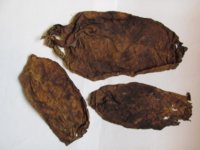Orson Carte
Well-Known Member
I'm hoping that someone can help me with a fermenting enquiry.As I'm a complete newcomer to home-grown tobacco I'm in the position of staring up a very steep learning-curve.I have built a kiln along very similar lines to that promoted (in this forum) by 'Brent atAmax' and have around 10kgs of (I think) Virginia leaf (of some sort) fermenting in six separate sealed plastic containers - like Brent does it.Now, I keep reading references to 'mold' - and, apologies if it sounds a little stupid - I wonder just what this mold actually looks like. I would imagine there are many different types but my dilemma is whether I'm looking at mold or merely observing the natural change of the leaf from brown to something darker.On the leaves of my 'oldest' batch (which have been cooking for almost three weeks) there are quite dark blotches, mixed with the original brown. These leaves aren't wet but they are quite pliable. The best way I can describe the colors is to say they look a little like those on a green sea-turtle's shell (when it's dead!) Is this how the fermentation change looks, or is it likely I've contracted the dreaded mold?I notice that on Brent's videos his finished product is tobacco that is very dark - almost, but not quite, black. So, maybe I'm worrying for nothing. Or am I?


